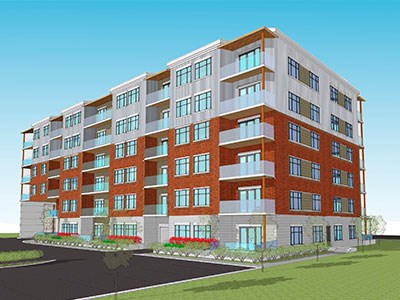It’s a steep learning curve for Ontario’s construction and design community to adapt to building wood mid-rises.
Despite changes to the Ontario Building Code last January allowing six-storey wood buildings, up from the previous limit of four, there’s been no surge of building activity as architects, contractors and clients are still warming to the idea of this new, elevated, green building option.
“It’s a question of moving an entire industry,” said Steven Street, a technical advisor for WoodWorks, a division of the Canadian Wood Council. “It takes time.”
The code changes are similar to that of British Columbia, the first province to adopt mid-rise wood-frame buildings in 2009. But in Ontario, there are more stringent safety requirements requiring the use of non-combustible materials in areas like stairwells.
“It’s not just a question of the code changing,” said Street, “there’s a lot of information which architects and engineers have to process in coming up with the right materials and structural solutions to make it happen.”
No exact figures are available on the number of wood mid-rises nearing the construction phase across the province, but Street estimates about a half-dozen projects are close to the permitting stage at the municipal level.
Of the developments that are close to the construction, most are taking place in the Greater Toronto Area, Kitchener-Waterloo, Cambridge and Hamilton where planners have embraced wood buildings as a viable option to build sustainable and affordable housing to fill space in high-density areas.
Street, who has spoken at mid-rise seminars across Ontario, said the design community is excited about the code changes and he anticipates greater activity by next spring.
While wood-framed houses are largely commonplace, Mike Baldinelli, a structural engineer and a principal at Strik Baldinelli Moniz in London, Ont., has encountered trepidation among clients in going to six stories.
For those developers experienced in building three and four-storey wood buildings, “it’s a no-brainer to go to six.”
“What I’m finding – and it’s tough – a lot of people are scared to build out of wood because they’ve never built out of wood. People are hesitant to take that leap because they just don’t know.”
Baldinelli’s firm is a leader in this construction having designed about 20 of the four-storey variety for clients over the past eight years.
In downtown London, his firm has designed a 69-unit, six-storey affordable housing project that’s awaiting city permit approval.
Another one is underway in Hamilton’s core, a six-storey high-end condo development, and a 100-unit, five-storey building in Oakville, a hybrid of concrete and wood, is going to permit this fall.
The hesitancy has nothing to do with fire safety concerns, but clients’ overall comfort level, and questions surrounding sound issues, durability and saleability, he said.
“They don’t want to be the guinea pig. They just aren’t confident enough, thinking they could have a concrete building for the same price.
“Developers are hesitant to say a building is made out of wood. People think it’s cheap.”
Affordability does work in wood’s favour. The cost of using wood in a building versus using concrete and steel materials is a savings of 10 to 12 per cent per square foot.
The building is lighter and it’s faster to erect; 12 to 14 months with a concrete building compared to eight to 10 months with wood.
“There are a lot of carrying costs you can save.”
As an exercise, Baldinelli’s firm redesigned and repriced a four-storey building in London, replacing the traditional building materials with wood, and bumped it up to six stories. The price went from $10.50 per square foot to $11 per square foot.
“Fifty cents a square foot is very little, in my opinion, up-cost, to go the extra two stories.
“There are design challenges since the building’s taller and wants to move more, so we have to control the structural characteristics of the building.”
To that end, they developed their own proprietary design software to address and calculate how a wood-framed building behaves with wind and seismic activity. Eventually they hope to spin out the technology for other consulting firms to use.
“I wouldn’t say we’re pioneering it, but we’re starting the process. We’ve designed the software and it calculates all the building deflections, how the building moves and it’s really quite accurate.”
While some developers still remain cool, Baldinelli finds city planners wholeheartedly endorse wood.
“It’s a great compromise. They get good densities with six stories and 60 to 100 units, whereas with four stories it’s only 40 or 50. And it fits with existing nature of the landscape in downtowns.”




